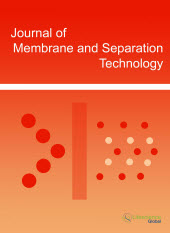jmst
Abstract : Dehydration of Organic Solutions by a Recirculated Air Sweep Pervaporation Process Using Anion-Exchange Hollow Fibers
|
|
Abstract: An air sweep pervaporation process with thin anion-exchange hollow fibers was investigated for various water-organic solvent mixtures at different operating conditions. It was found that flux and separation factor increased with a decrease of the dielectric constant of the organic solvent. When the temperature of the process was increased, the flux increased. At feed temperatures of 65–70°C it was possible to reduce the water concentration in a 3–10% isopropyl alcohol (IPA) solution to 0.5%. The energy requirement for decreasing the water concentration in IPA from 3–10% to 0.5% was 100–225 kWh ton-1. Keywords: Solvent dehydration, pervaporation, anion exchange hollow fibers, dielectric constant. Download Full Article |
Abstract : Filtering Brackish Water by Photovoltaic-Powered Membrane
|
|
Abstract: Photovoltaic-powered membrane was taken to filter brackish water. Effect of ammonia concentration, pressure and salinity on ammonia and total dissolved solids (TDS) removal, water recovery and energy consumption had been investigated. Results show that ammonia concentration did not influence ammonia and TDS removal, water recovery, and energy consumption obviously. Results of ammonia concentration of 10, 20 and 35 mg/l were similar to that of 5 mg/l. For salinity, the better filtration was achieved when the concentration of salinity was lower. With increment of pressure, ammonia and TDS removal increased simultaneously. The ammonia and TDS removal of more than 98% attained with the water recovery of 40.6% at the energy consumption of 2.0 kWh/m3. It illustrates that salinity and pressure were definitely crucial to brackish water filtration with photovoltaic-powered membrane. Keywords: Photovoltaic-powered membrane, Reverse osmosis, Brackish water, Salinity, Total dissolved solids (TDS), Energy consumption. Download Full Article |
Abstract : The Economics of Reverse Osmosis Desalination Projects
|
|
Abstract: Desalination applications based on reverse osmosis (RO) technology today comprise over 50% of the capacity of all desalination systems worldwide and represent 75-85% of new desalination projects being implemented. The major reason for the shift in desalination projects to RO technology is the high energy efficiency of the RO process. There are three major application categories of large capacity, RO-based desalination projects: brackish RO; advanced municipal wastewater reclamation; and seawater RO. In the two first categories (brackish RO and wastewater reclamation), the systems’ configuration and equipment components are well defined. Therefore, project costs and operating expenses are fairly predictable. In seawater RO desalination systems, the RO process configuration is also very similar; however, some variability exists regarding the configuration of seawater water delivery and feed water pretreatment. The rest of the system’s components and system operation methods are very uniform. However, an evaluation of published cost data of medium- to large-scale water RO desalination projects illustrates significant variability in costs of desalination systems. This paper will analyze current economic conditions of seawater desalination, and highlight the limitations and possibilities of additional improvements of the economics of the SWRO desalination process. Keywords: Desalination, Reverse osmosis, energy, investment, cost. Download Full Article |
Abstract : EDITORIAL: Special Issue on the Membranes for Carbon Dioxide Separation / Capture Applications
|
|
Editorial Download Full Article |























